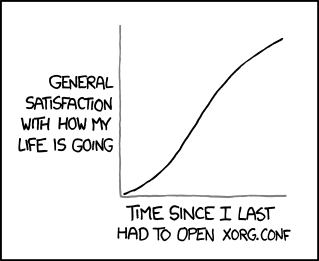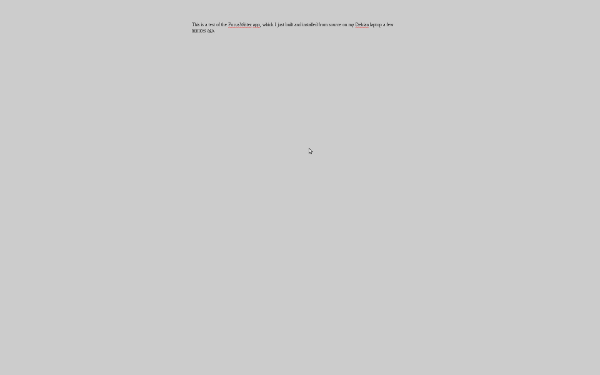[2023]
[2022]
[2021]
[2020]
[2019]
[2018]
[2017]
[2016]
[2015]
[2014]
[2013]
[2012]
[2011]
December
November
October
September
August
July
June
May
April
March
February
January
[2010]
[2009]
[2008]
[2007]
[2006]
[2005]
[2004]
[2003]
[Fri Oct 28 18:28:14 CDT 2011]
Just ran into an issue while trying to upgrade to Firefox 7 on my Apple laptop. I happily dragged the icon to the
Applications folder, was asked if I wanted to replace the old version that was
already installed and, when I hit OK, was greeted with an error message
explaining that the
$ sudo lsof -V | grep libsmime3.dylib
Password:
vpnagentd 89 root txt REG 14,2 324728 2049092 \
/Applications/Firefox.app/Contents/Macos/libsmime.dylib
$ sudo kill -9 89
[Thu Oct 27 16:48:00 CDT 2011]
Dave Pogue wrote a few days ago about using Dropbox as a collaboration tool. I have to agree that Dropbox is an excellent tool to quickly copy files from one device to another, or perhaps even as a simple (and limited in size) backup service. However, I'm not so sure I'd recommend it as a tool to collaborate on a document. Yes, it does seem to do the trick for Dave Pogue, but that is only because he has a very well defined need (i.e., writing, editing and proofreading chapters of a book). More power to him. I mean, if Dropbox does what you need, by all means, make it your default tool. Yet, for true collaboration on a given document I have found Google Docs to be far more useful. Why? Well, it includes features such as revision history and ease to share a file. Don't forget that all Dropbox does is sync the contents of a folder on your local hard drive with the copy saved on their servers. In other words, nothing stops two or three people from working separately on the same document (ignoring that they all are doing it at the same time) and later find out that they have conflicting versions of the same document. In other words, Dropbox is not a collaboration tool, no matter what Dave Pogue says. If it works for you, fine, use it. But if you truly need a real collaboration tool, then use something else. {link to this story}
[Thu Oct 27 14:27:50 CDT 2011]
A good friend has shared a couple of YouTube videos with me that are very cool. The first one shows Logstalgia, a visualization tool for website access logs:
The second one shows Gource, another visualization tool, that does something similar but with the code source trees:
{link to this story}
[Thu Oct 20 14:52:57 CDT 2011]
Although I'm not one of those people who is very worried about privacy issues,
I found this entry in the Usemos Linux blog (NOTE: in
Spanish) quite interesting. It discusses Linux tools that can be used to
safely erase your partitions or files, such as
[Tue Oct 18 08:10:11 CDT 2011]
If, like me, you are running Debian Squeeze, you may deeply dislike that whimsical login background they
chose by default. Even worse, since Squeeze uses GDM3, the GUI configuration
tool is quite limited and doesn't allow you to change it easily. So,
what to do? Well, pull up your sleeves and go down to the good old ways:
edit a text configuration file by hand. In this case, you will need to edit
the
Notice how I changed it to use the
# Use a specific background #/desktop/gnome/background/picture_filename /usr/share/images/desktop-base/login-background.svg /desktop/gnome/background/picture_filename /usr/share/images/desktop-base/whirlpool.jpg
I read somewhere else that it is also possible to uninstall GDM3 and install the old GDM package instead. One way or another, I'm not sure I agree with the decision by the Debian developers to ship with the newer version of GDM (which, obviously, is not completed, since the GUI configuration tool works but it barely has any capabilities) with the old GNOME 2. What for? What do they accomplish by doing that? Sure, at least both versions are on the repos and it is easy enough to switch to the other release. Other distros don't make it so easy. {link to this story}
[Fri Oct 14 17:39:08 CDT 2011]
Just had to register my IRC nick with Debian's server, and it occurred to me that other people may also be interested in how to do this. Simply run the following command to register:
After that, once the nick is registered, you must identify yourself every time you return to the same IRC network by using the following command:
/msg nickserv register [password] [email_address]
That's all there is to it. {link to this story}
/msg nickserv identify [password]
[Thu Oct 13 18:24:31 CDT 2011]
Sad news. Todaty, it has been made public that Dennis Ritchie, the father of both UNIX and the C programming language, has died As Rupert Goodwin explains on ZDNet:
And then, he goes on to add:While the introduction of Intel's 4004 microprocessor in 1971 is widely regarded as a key moment in modern computing, the contemporaneous birth of the C programming language is less well known. Yet the creation of C has as much claim, if not more, to be the true seminal moment of IT as we know it; it sits at the heart of programming —and in the hearts of programmers— as the quintaessential expression of coding elegance, power, simplicity and portability.
...and that is how Unix became so central to the whole Internet experience, at least during its first phase. {link to this story}The mid-'70s were a period of great experimentation and variation in computer hardware design, which made life difficult for software writers who had to either limit their programs to running on one particular device or spend a greeat deal of time and energy recreating their work for each new platform.
In response to this problem, Ritchie designed a computer language, C, that could be quickly and easily moved between different hardware. Programs that were written in C, provided they followed the rules, would then run with little or no modification on any computer that could itself run C.
Thompson and Ritchie then rewrote Unix in C, giving the operating system the same ease of portability. Programmers could then learn one operating system, one set of tools and one language, and find those skills nearly universally applicable. Likewise, once a hardware manufacturer had put C on its new design, the machine could use a vast pool of existing software and talent. One side effect of this was that Unix became the natural home for experimental, then practical, inter-networking between different systems.
[Wed Oct 12 10:10:00 CDT 2011]
Haha! Absolutely true! However, I suppose plenty of Linux newbies won't even understand what this is all about. Taken from xkcd, the web comic:
{link to this story}

[Wed Oct 12 09:46:58 CDT 2011]
Searching around for applications that I could use to write short stories, I
found FocusWriter. Yes, there
are more ellaborate applications. Yes, also in the Linux world. However,
I was looking for a simple application that just got out of the way and let
me write without being disturbed. This one seemed to fit the description
but... alas, it has not been ported to Debian Stable (squeeze) yet. So, I grabbed the source code,
unpacked it, read the INSTALL file to see the directions and got ready to
build the binary... just to run into the first roadblock while running the
qmake command:
The solution? Simply run the following command as root to install the needed prerequisites:$ qmake Package hunspell was not found in the pkg-config search path. Perhaps you should add the directory containing `hunspell.pc' to the PKG_CONFIG_PATH environment variable No package 'hunspell' found Package libzip was not found in the pkg-config search path. Perhaps you should add the directory containing `libzip.pc' to the PKG_CONFIG_PATH environment variable No package 'libzip' found (...)
Onto the next step. Actually, onto the next roadblock. This time around, it happened when running the# apt-get install libhunspell-dev libzip-dev
make command to build the binary:
Once again, it is relatively easy to fix. Just run the following command as root to install the prereq:$ make -pipe -O2 -I/usr/include/hunspell -Wall -W -D_REENTRANT -DQT_NO_DEBUG -DQ T_GUI_LIB -DQT_CORE_LIB -I/usr/share/qt4/mkspecs/linux-g++ -I. -I/usr/include/qt 4/QtCore -I/usr/include/qt4/QtGui -I/usr/include/qt4 -Ibuild -o build/alert.o sr c/alert.cpp In file included from src/alert.cpp:20: src/alert.h:23:19: error: QWidget: No such file or directory src/alert.cpp:22:18: error: QEvent: No such file or directory src/alert.cpp:23:34: error: QGraphicsOpacityEffect: No such file or directory src/alert.cpp:24:23: error: QHBoxLayout: No such file or directory src/alert.cpp:25:18: error: QLabel: No such file or directory src/alert.cpp:26:20: error: QPainter: No such file or directory src/alert.cpp:27:21: error: QTimeLine: No such file or directory src/alert.cpp:28:23: error: QToolButton: No such file or directory (...)
That allowed me to build the binary. I then just ran# apt-get install libqt4-dev
make install
and the executable was installed in /usr/local/bin, as it
should. Here is a screenshot:
Sure, spartan. Like I said, it's precisely what I was looking for. You can change the background to a picture or whatever else. Check out the website for more information. Also, if you are interested, read this review and this document explaining how to use FocusWriter. {link to this story}

[Tue Oct 4 15:27:38 CDT 2011]
A good friend recently installed Ubuntu and deeply disliked the notification feature that automatically displays information in a box when people log into IM, etc. It wasn't difficult to find a couple of articles online explaining how to disable libnotify: this one explains how to do it from the command line, while this other one shows how to disable the notifications in Pidgin using the GUI. As far as I know, he followed the directions in the first article to disable the feature system-wide, and it worked flawlessly. Basically, you just run the following command:
The change will not take effect until the next reboot, though. {link to this story}$ sudo mv /usr/share/dbus-1/services/org.freedesktop.Notifications.service \ /usr/share/dbus-1/services/org.freedesktop.Notifications.service.disabled
[Tue Oct 4 15:15:03 CDT 2011]
Information Week publishes a nice piece on 10 great Android applications that introduced me to a few apps I had not heard of (yeah, I'm new to Android), such as Evernote or Fuze Meeting. While in Spain I had a Nokia E65. Since I knew I was moving back to the US, it just did not make much sense to invest in a new phone. Now, after arriving in Minnesota, I got an HTC Droid Incredible 2 and am quite pleased with it. I'm still investigating its functionality and testing apps, but I definitely love the flexibility of mobile communication. {link to this story}